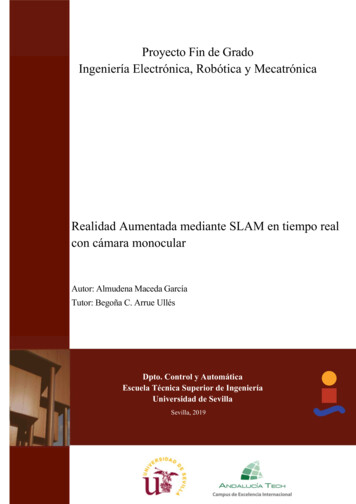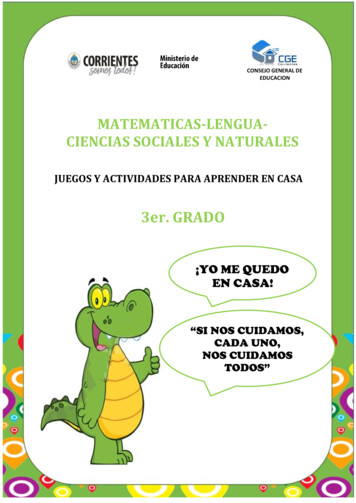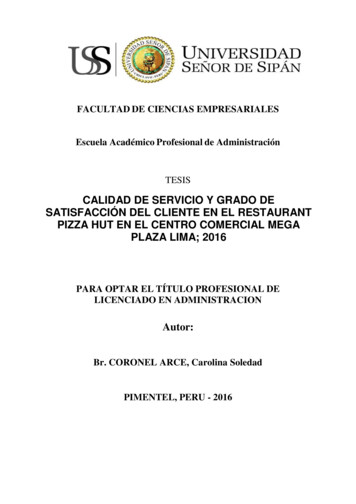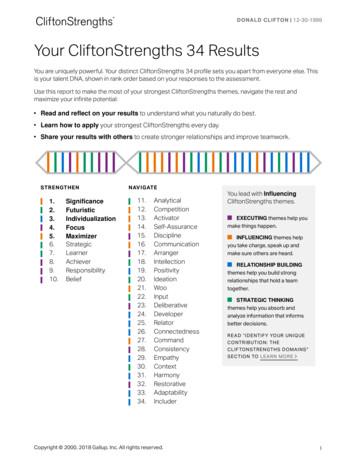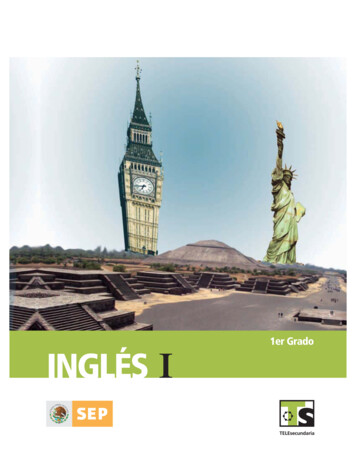
Transcription
1er GradoINGLÉS I
La elaboración de Inglés I. Apuntes estuvo a cargo de la Dirección General de Materiales Educativos de laSubsecretaría de Educación Básica.Secretaría de Educación PúblicaJosefina Vázquez MotaSubsecretaría de Educación BásicaJosé Fernando González SánchezDirección General de Materiales EducativosMaría Edith Bernáldez ReyesCoordinación generalMaría Edith Bernáldez ReyesElaboración de textosClaudia Yvette Gómez MartínezJezabel Barrera FuentesRevisiónMaría Cristina Martínez MercadoJorge Barbiere MejíaClaudia Elín Garduño NéstorAsesoría pedagógicaKarina Bustos HernándezAlejandra Monserrat Castillo RobledoCorrección de estiloEstela Maldonado ChávezIlustración de portada e interioresMarco Tulio Ángel ZárateFormación y correcciónDirección Editorial DGMEPrimera edición, 2008 (ciclo escolar 2008-2009)D.R. Secretaría de Educación Pública, 2008Argentina 28, Centro,06020, México, D.F.ISBN 978-968-01-1670-6Impreso en MéxicoDISTRIBUCIÓN GRATUITA-PROHIBIDA SU VENTA
ÍndicePresentation / PresentaciónIntroduction / Introducción9Classroom Language / Lenguaje en el salón de clases101315182225Lesson 1Lesson 2Lesson 3Lesson 4Lesson 5Lesson 629Unit 1 / Personal Identification / Identificación personal323639424446495255576064666971737577Lesson 1Lesson 2Lesson 3Lesson 4Lesson 5Lesson 6Lesson 7Lesson 8Lesson 9Lesson 10Lesson 11Lesson 12Lesson 13Lesson 14Lesson 15Lesson 16Lesson 17Lesson 1889Unit 2. Actions in progress/ Acciones en progreso929699103106109113117121Lesson 1Lesson 2Lesson 3Lesson 4Lesson 5Lesson 6Lesson 7Lesson 8Lesson 9Hello! Goodbye!How do you spell it?How old are you?Sit down!When’s your birthday?What’s the meaning of sharpener?At a partyHer name is AzucenaMy father is a mechanicI’m a studentWhat do you do?Are you a student?My school ID cardWhere do you live?I live in a small townDavid is a soccer playerAt the archaeological siteWhere are you from?Are you from Brazil?A creature from the spaceNationality means nacionalidadWhat about your brother or sister?Send me an e-mailRewievSending an e-mailThis is Samuel s sweaterWhose are these shorts?That is my favorite jacketThese blue jeans are comfortableAre these your sunglasses?Mini CheckLooking for ArturoSpeaking on the phone
n 10Lesson 11Lesson 12Lesson 13Lesson 14Lesson 15Lesson 16Lesson 17Lesson 18Lesson 19Lesson 20Lesson 21Lesson 22Lesson 23Lesson 24Getting ready to the partyEnjoying a partyWhat’s happening at the party?A day in AcapulcoMini CheckProject: A class magazine Part oneProject: A class magazine Part twoProject: A class magazine Part threeProject: A class magazine Part fourProject: A class magazine Part fiveProject: A class magazine Part sixProject: A class magazine Part sevenReviewReviewReview169 Unit 3. Hobbies, leissure and sport/ Pasatiempos, tiempo libre y 18221223226228Lesson 1Lesson 2Lesson 3Lesson 4Lesson 5Lesson 6Lesson 7Lesson 8Lesson 9Lesson 10Lesson 11Lesson 12Lesson 13Lesson 14Lesson 15Lesson 16Lesson 17Lesson 18Lesson 19230Lesson 20231Lesson 21I like playing videogamesI like to ride my bikeI like moviesI love soccerMy mother likes going to the moviesMini CheckDo you like tennis?Does your father like soccer?Does she like cooking?I like vegetables and fruitsDavid loves comicsMini CheckWould you like to go to a party?Why don’t we go to the movies?Let’s eat Mexican foodShall we go to a rock concert?Would you like to see a movie today?No, thanks I hate horror moviesProject: We invite to you to our St Valentine’s celebrationPart oneProject: We invite to you to our St Valentine’s celebrationPart twoReview243 Unit 4. Daily Life/Vida ssonLesson123456Long distance callIt’s quarter past eightWhat time is it?What time does the next bus leave?I start at 8 o clock in the morningI wake up at 11:30 am on Saturdays
1324327328330332334339Lesson 7Lesson 8Lesson 9Lesson 10Lesson 11Lesson 12Lesson 13Lesson 14Lesson 15Lesson 16Lesson 17Lesson 18Lesson 19Lesson 20Lesson 21Lesson 22Lesson 23Lesson 24Lesson 25Lesson 26Lesson 27Lesson 28Lesson 29Lesson 30Mini CheckJessica gets up at 6 o’clockJessica loves basketballHe studies in Queens UniversityDoes he wake up at half past five?Romina doesn’t have a sisterI visit the dentist twice a yearMini CheckHow often do you have English class?Today is my birthdayDoes she usually have breakfast at 8 o’clock?Are you healthy?Sending an e-mailCrocodiles are endangered speciesElephants live in AfricaDo Bengal tigers live in the forest?Where do grey whales travel in the winter?Mini CheckProject: Come and visit our school zoo Part oneProject: Come and visit our school zoo Part twoProject: Come and visit our school zoo Part threeProject: Come and visit our school zoo Part fourReview Part oneReview Part two351 Unit 5. Places and buildings/Lugares y 93396399400401402402403Lesson 1Lesson 2Lesson 3Lesson 4Lesson 5Lesson 6Lesson 7Lesson 8Lesson 9Lesson 10Lesson 11Lesson 12Lesson 13Lesson 14Lesson 15Lesson 16Lesson 17Lesson 18Lesson 19Lesson 20Lesson 21Welcome to PueblaI’m looking for a greengrocerA brochure with interesting placesIs there a bank near here?Where is the bank?This is a map of my townMini CheckThe park is on Allende StreetLook at the mapGo straight, turn left, turn rightWelcome to my schoolHow can I get to the gas station?How can I get to The Palace of Fine Arts?Mini CheckHow can I get to your house?Project: A travel brochure Part oneProject: A travel brochure Part twoProject: A travel brochure Part threeProject: A travel brochure Part fourProject: A travel brochure Part fiveReview
PresentaciónLa Secretaría de Educación Pública, comprometida con la comunidad detelesecundaria —autoridades, docentes, alumnos, padres de familia—, se dio ala tarea de fortalecer el modelo de enseñanza-aprendizaje de esta modalidadeducativa. Este modelo fortalecido ofrece materiales que apoyan de manerasignificativa la comprensión y dominio de los contenidos de los planes deestudio vigentes.La serie de Apuntes Bimodales de Telesecundaria está desarrollada para quemaestros y alumnos compartan un mismo material a partir del trabajo deproyectos, estudios de caso o resolución de situaciones problemáticas. Coneste objetivo se han desarrollado secuencias de aprendizaje que despiertan elinterés de los alumnos por la materia, promueven la interacción en el aula ypropician la colaboración y la participación reflexiva, además de que empleanuna evaluación que orienta las decisiones tanto del docente como del alumno yestablecen estrategias claras de vinculación con la comunidad.Estos materiales, que la SEP pone ahora en manos de alumnos y maestros,expone de manera objetiva los temas, conceptos, actitudes y procedimientosnecesarios para un mayor y mejor entendimiento de cada una de las materiasque comprende la serie.El empleo de estos Apuntes Bimodales y las sugerencias que brinde lacomunidad de telesecundaria darán la pauta para el enriquecimiento y mejorade cada una de las ediciones de esta obra que busca contribuir a unaeducación equitativa y de calidad en el país.SECRETARÍA DE EDUCACIÓN PÚBLICA
En los !PUNTES de Inglés se utilizaron iconos que representan determinadas actividades. Losincluimos a continuación para facilitar su identificación y uso.Speak / HablarThink / PensarPlay / JugarWrite / EscribirRead / Leer
Introduction/IntroducciónClassroom language / Lenguaje en el salón de clasesPurpose/PropósitoEl alumno:El propósito de esta unidad es proporcionar a los estudiantes algunasexpresiones básicas usadas dentro del salón de clase que le permitiráncomunicarse en Inglés durante las lecciones del idioma extranjero.Topics/ TemasLesson 1Hello! Goodbye!Lesson 2How do you spell it?Lesson 3How old are you?Lesson 4Sit down!Lesson 5When’s your birthday?Lesson 6What’s the meaning of sharpener?6 sessionss, 2 weeks / 6 sesiones, 2 semanas
Lesson 1Hello! Goodbye!Read1. Look at the pictures.Match the conversation (1, 2, 3) to the pictures.Observa las imágenes. Escribe el número de la conversación correspondiente acada uno.1)Bus driver:Pedro:Bus driver:Good morning, My name is Paul. Welcome to the bus!My name is Pedro. Good morning sir.Nice to meet you Pedro.2)Pedro:Okan:Pedro:Okan:Pedro:Hi. My name is PedroHello Pedro. I am Okan.How are you?I’m fine, thanks. And you?OK.3)Bus driver:Pedro:Group of SS:Bus driver:Have a nice day guys!Bye Paul!Goodbye!See you in the afternoon!
2. Indicate ; the time of the conversations.Indica ; el tiempo en que se desarrollaron las conversaciones.morningThinkafternooneveningWrite3. Complete the information. Use the words in the box.Completa la información. Usa las palabras del cuadro. Conversation 1) is and Conversation 2) is .4. Look at the pictures and complete the dialogue.Observa las imágenes y completa los diálogos.Memo:Mr. Gómez:Memo:Mr. Gómez: Good , Mr. Gómez.morning Memo. are you?I’m , thanks, and you?
Ema:Rodrigo:Ema:Rodrigo:. My name is Ema.Ema. am Rodrigo.How are ?I’m fine, . Speak5. In pairs, create a dialogue, similar to the ones in 4. Then present it to the class.En parejas, elaboren un diálogo similar a los del ejercicio 4. Posteriormentepreséntenlo a la clase.6. Complete the chart.Completa el cuadro.GreetingsGood morningGood afternoonGood eveningFarewellsGood byeSee you Time6 a.m. – 12 p.m.SpanishSpanishBuenas nochesNos vemos
Lesson 2How do you spell it?Read1. Fill in the blanks with the words in the box.Completa los espacios con las palabras del udent:Teacher:Zapata:Teacher:Good morning class. I’m going to call the roll.Number one, Álvarez.Present.Number two, BonillaHere.Number , HuertaAbsent.Number twelve, LinaresPresentNumber , SuárezPresent.Number twenty – three, Mmm ! Tes, tech.It is Texcalpa.How do you spell it?T-E-X-C-A-L-P-AOK. Number twenty – three,TexcalpaPresentNumber twenty – nine, VigueraAbsent.Number , ZapataPresent.OK. Let’s start the class.eighttwentythirty Think 2. Look at the underlined words in the dialogue. Use them to complete thesesentences.Completa las ideas con las palabras subrayadas en el diálogo.1. You answer or when you are in the class.2. You answer when somebody is not in the class.3. Look at the words in bold in exercise 2. What do they mean?Observa las palabras en negritas en el ejercicio 2. ¿Qué significan?
WriteSpeak3. Look at the table below. Repeat the pronunciation of the letters.Observa la tabla anterior. Repite la pronunciación de las letras.LETRAA –eiB –biC – ciD – diE–iF – efG – yiH – eichI – aiJ – yeiK – keiL – elM – emLETRAN – enO – ouP – piQ – quiuR – arS – esT – tiU – iuV – viW – dobliuX – ecsY – uaiZ – dzi4. Create a classroom directory. Ask 5 partners for their full name. Ask them tospell their name or family name and take notes. Follow the example.Crea un directorio. Pregunta a 5 compañeros su nombre completo. Pídelesque deletreen su nombre o su apellido y toma nota. Sigue el ejemplo.What’s your name?It’s AlvaradoA-L-V-A-R-A-D-O My name is Juan.What’s yourfamily name?How do you spellit?
MY CLASSROOM DIRECTORYFamily name(s) oName Lesson 3How old are you?Read1. Read the dialogue from the previous lesson again. Complete this table with themissing words.Lee otra vez el diálogo de la lección anterior. Completa la tabla con las palabrasque faltan.NÚMEROS12345678910111213141516171819 ourteenFifteenSixteenSeventeenEighteenNineteen
NÚMEROS212223 .29303132 .405060708090100NUMBERSTwentyTwenty oneTwenty twoThirtyThirty oneThirty two FortyFiftySixtySeventyEightyNinetyOne hundredSpeak2. Practice saying the numbers.Practica repitiendo los números.Think3. Look at the numbers 21 – 29, 31 – 39, 41 – 59, etc. What do they have incommon? How are these numbers formed in English? Write the rule.Observa los números 21-29, 31-39, 41-59, etc. ¿qué tienen en común? Cómo esque estos números se forman en inglés? Escribe la regla. Write4. Answer the following questions about yourself.Contesta las siguientes preguntas.
How old are you?How old is your teacher?How old is your best friend?How old is your mother?How old is your father?I am years old.He/she is years old.He/she is years old.She is years old.He is years old. Speak5. Ask your partner the questions above. Write his/her answers.Realiza las preguntas del ejercicio anterior a tu compañero y anota susrespuestas.Partner’s name:Age:Teacher’s age:Best friend’s age:Mother’s age:Father’s age:6. Write the result with the word in English. Follow the example.Escribe el resultado en inglés de las siguientes operaciones. Fíjate en elejemplo.60 - 2 20 5 twenty five30 - 1 70 3 9 x 9 30 - 8 thirty eight40 6 90 4 7. With numbers you can say your age.Con los números también puedes decir tu edad.How old are you?How old is María?How old is Luis?I am twelve years old.She is thirteen years old.He is fourteen years old.How old is Sarah?
How old is he? Lesson 4Sit down!Read1. Look at the pictures in exercise 2. Are these situations familiar to you?Observa las imágenes en el ejercicio 2. ¿Te son familiares estas situaciones?2. Match the pictures (1,2,3) with the dialogues.Escribe sobre la línea el número que relacione la imagen con el diálogo.1)2) 3)
I m sorry.I m late!May I come in? Yes, Peter closethe door!Sit down, please! And openyour book at page 25Every
La elaboración de Inglés I. Apuntes estuvo a cargo de la Dirección General de Materiales Educativos de la Subsecretaría de Educación Básica. Secretaría de Educación Pública Josefina Vázquez Mota Subsecretaría de Educación Básica José Fernando González Sánchez
